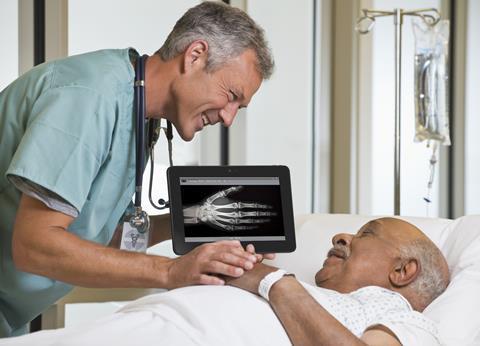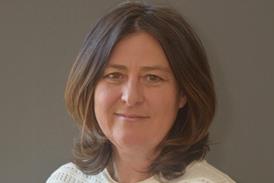Seamless flow of information between patients, NHS bodies and other organisations is now achievable – and one result should be much greater patient empowerment. Matthew Shelley reports

The next great medical blockbuster won’t be a superdrug but the emergence of the empowered patient. That’s the view of GP and information technology pioneer Dr Amir Hannan, but it’s an opinion which is rapidly gaining traction elsewhere.
The consumer appetite for digital fitness trackers, for shopping, banking and chatting online shows a willingness to adopt technology that many believe should be warmly welcomed by the NHS. Healthcare companies across the world are looking far beyond the idea of paperless environments to a future that is truly digitised – and even digestible.
‘People will want to know why they can transfer money in moments but can’t get blood test results for a week’
Effective use of digital solutions offers opportunities for service providers to meet rapidly growing demand, and an area of great promise is to involve the patient more closely in their own care.
But there are hurdles – Dr Hannan argues that there is a huge difference between giving people data and making them truly informed. As a Tameside and Glossop Clinical Commissioning Group board member for information management and technology, Dr Hannan is nationally known for his advocacy of patient record access and understanding.
“In an information age people want to find out more and more about their health and also be part of the process,” he says.
One third (nearly 4,000) of his patients have signed up to his PIN controlled online “tethered” record system which allows them to access and interact with their information.
The approach he has developed over the last decade has been well ahead of government targets for patient access to online records by 2015. It has extensive safeguards to ensure that patients are guided to reliable sources of explanation about the data in their records.
“Research by the British Library a few years ago showed that while the Google generation is very good at browsing information online they are less good at appraising it. So this is not about just reading what your ‘rhubarb’ levels are, it’s about finding out what those ‘rhubarb’ levels actually mean,” says Dr Hannan.
With proper groundwork in place he sees big opportunities for engagement between the NHS and the public, and believes the targets for a paperless NHS do not provide enough of a push for change.
‘You’re going to have this dual paper and electronic system potentially for some years. Where that is used there’s scope for errors’
“The next superdrug will not be a drug at all but the empowered patient,” he says, before adding: “This year I want to see us reaching out to many more patients… If we set a target like 2018 for things to happen, then it will be 2025 before they do.”
Dr Hannan and others recognise that empowerment can only flourish when the NHS itself makes effective use of technology.
The advantages of electronic records, and better use of IT more generally, were trumpeted in 2013 when a Pricewaterhouse Coopers report (just ahead of Jeremy Hunt’s 2018 paperless NHS challenge) projected savings of £4.4bn a year.
Dr Masood Ahmed on the real challenge
A gauntlet was thrown down for NHS organisations to become paperless by 2018 – but is this the real challenge or should we think bigger?
As a clinician I believe that the vision should be about more than going paper free; it should be about embracing the digitalised world. Patients increasingly demand that information should be available in digital format and expect data transparency with convenient access to their information.
This will only grow with the shift to personalised medicine and care. Healthcare organisations must think differently about this challenge for new solutions to emerge and lead the way forward.
The historical approach to getting patient information digitised has been piecemeal, time-consuming, painful and costly. Electronic patient records have been catalysts for more data collection and advanced data management. This supports the trend towards population health management.
For many years, the diagnosis and treatment of patients was performed on a personal basis – one doctor, one patient with the diagnosis and treatment options carried in the clinician’s head or the small “black bag” of simple instruments.
With the advent of pharmaceuticals and laboratory testing, clinicians expanded their roles to both administer these treatments (eg pharmacists) and perform these tests (eg pathologists). This has increased the size of the community and spawned additional information to be stored and processed.
The requirements for collecting, storing, and processing all of the information relevant to health has come to depend on establishing a personal and ubiquitous relationship. Today, we have the opportunity to establish healthy relationships by providing both individual and wearable devices for use in our personal lives and enterprise systems to discover, predict, and inform the community.
This will require innovative technology and customisable solutions involving five trends: cloud, mobility, big data, software- defined anything and evolving security threats. All impact how organisations plan, deploy, and manage IT and offer a roadmap to a truly digital healthcare world that will impact patient outcomes.
These are the areas, and visions, which are needed to drive the NHS forward. We must be more than paperless, we have to be digital.
Dr Masood Ahmed is UK leader, Dell Healthcare
But progress is patchy, even in computerising records. Emma Stockwell, a partner in the health business group at law firm Hill Dickinson told the Westminster Health Forum last year: “Many NHS bodies that I work with at the moment have a dual system of paper records and electronic records… You’re going to have this dual system potentially for some years. Where that system is used there’s scope for errors – potentially for records to go missing.”
A white paper by Dell Healthcare, exploring the challenge of going paperless, emphasised that it had to be part of wider developments and “cannot be achieved in isolation and neither can the decisions on the types of technology in which to invest”.
‘A truly agile and paperless organisation will require the people and technology infrastructure to exist that supports the new ways of working’
“A truly agile and paperless organisation will require the people and technology infrastructure to exist that supports the new ways of working. Therefore, any decision on investment must facilitate employee and patient choice in how and where care is provided,” the paper said.
Brett Cooper, a senior IT consultant at Dell Healthcare, says the NHS needs to look to the consumer market: “People are taking technology into every aspect of their lives.
“Of their own volition they wear bands which count paces, measure heartbeats and all sorts of things and then share it with their friends. We need a healthcare IT economy which builds on the consumer model.”
The number of wearable devices linked to the internet is expected to reach 25 billion by 2020 and there are already 100,000 healthcare apps available for smartphones.
The next range of developments could well be through ingestible sensors and smart pills, which will help in areas such as monitoring whether patients are taking their medication properly.But technological potential can only become everyday reality with the seamless flow of information between NHS organisations, social care providers and patients.This already happens in other domains, for example Dell provides the software behind BACS payments for bank accounts.
Information flow
“The key is the underlying infrastructure, the stuff behind the scenes, the stuff you don’t see,” says Mr Cooper. “Getting that right is what’s most important. The financial sector could simply not function without instant information.
“Why isn’t this the case for a blood test? People will increasingly want to know why they can transfer money round the world in moments but can’t get the results from a blood test for a week. The test takes hardly any time at all. The issue is the efficient flow of information.”
Once this is in place he believes that genuine transformation is possible, including far greater engagement between clinicians, patients and carers. And in a world where people are well disciplined in dealing with sensitive financial matters online, he thinks there is ample scope for secure and responsible sharing and augmenting of health information.
This might include allowing patients the option of giving relatives or carers permanent or one-off access to their information – possibly immediately after a hospital or GP appointment.
Some parts of the NHS need to embrace rather than resist new approaches, according to Mr Cooper: “The future state is based on consumer use. Hospital IT departments should not prescribe how people use IT, they should not prevent the usage of new technologies, they should promote adoption and educate their users on safe and appropriate use.”
CASE STUDIES
Locala community partnerships
When many healthcare staff in the UK arrive at work they feel they are walking into an IT museum – at Locala they are looking into the future. As a community care organisation providing NHS services to 400,000 people in Kirklees and beyond, it is working with Dell Healthcare to enable its 1,300 staff to seize and exploit the benefits of digital working.
The impact has been dramatic – changing work practices, cutting referral times, reducing costs and improving work-life balance. At the heart of the progress is the idea that consumer use of technology will drive service change and patient expectation, and that healthcare providers should be leading not following.
‘Staff are equipped with mobile devices, which they can use to do anything from creating and accessing records and work schedules through to video conferencing’
Jim Barwick, Locala executive director of transformation, says: “Most people use the latest technology in their own lives, but they often go to work and feel like they are stepping back four or five years in time. We are turning that on its head.”
Staff are all equipped with high quality mobile devices, such as laptops, which they can use to do anything from creating and accessing records, work schedules and a multitude of other data through to video conferencing.
The time savings are huge, for patients and staff. All podiatry patients have the option of a virtual first appointment, which can cut referral and treatment times. Likewise, community nurses who have concerns about a patient can take immediate advice from more experienced colleagues.
In a 40 per cent rural area, taking in remote communities in the Pennines, there are clear benefits for staff who can get straight out on the road each morning, without having to go to the office to collect work schedules or return to input results. Employee surveys show that the flexibility offered by mobile working is highly valued – it’s now perfectly straightforward to fit a school run around work commitments.
Mr Barwick, who was a nurse before going into management, says: “We really are promoting innovation and encouraging people to work differently. This truly liberates people. If we told staff that their kit was going to be taken away, there would practically be a riot.”
One impressive validation of the large scale shift to mobile technology is that it has yielded savings that have allowed Locala to cope with a 4 per cent monthly rise in demand, plus increasingly complex cases, without extra funding.
As a social enterprise, Locala wants employees to feel fully committed to its objectives of delivering high quality care to patients in, or near, their own homes. It also wants them to feel that the electronic kit is theirs, not just for work but for home uses such as online shopping – if they trust staff to treat patients, they can trust them to look after a computer.
‘Staff are eager to find ways to use Facebook, Twitter and other platforms to engage with the community’
This approach has generated a culture where staff are eager to find ways to use Facebook, Twitter and a multitude of other platforms to engage with the community.
Technology can also be effective for engaging with hard to reach patients. One example is that the willingness of school nurses to video conference young people when they are secure in their own homes can help combat stigma. Nonetheless, there is effective security and clear guidelines on appropriate use.
This year Locala and Dell plan another major leap forward with the introduction of patient-held records. Mr Barwick sees this as a welcome shift from a system where patient information is exchanged and discussed by a range of healthcare professionals but the patient is left “in splendid isolation”.
“Patient-held records will bring real change. They will be able to see and input information and sit with a clinician to create a care plan that suits them. This changes the nature of care and gives the patient more responsibility with the clinician in a coaching or mentoring role,” he adds.
When chronic and long term conditions dominate the community healthcare landscape, Locala believes such developments are vital. But according to Mr Barwick, the acute sector should also be championing digitised community care: “There’s a huge shift to get people out of hospital as quickly as possible as that’s where the real cost is. Adoption of this kind of technology should be driven by the acute and social sector as they benefit as well.”
Collaboration models
Collaborations between clinicians, healthcare organisations and global business can be vital to progress in the NHS. This is the view of Dr Masood Ahmed, UK leader at Dell Healthcare, who sees the role of technology as going far beyond the government’s ambition for paperless electronic patient records.
At the General University Hospital in Prague, Dell is helping with advanced clinical research into drug optimisation, using a software package called Statistica. The results could bring exactly the benefits which NHS management is urgently seeking.
‘On the move: tablets and smartphones allow staff to be more flexible and efficient use to transfer their records to a personal account that can be accessed and shared anywhere’
“The goal is to ensure that young patients receive drug doses corresponding to their ages, clinical conditions, genetic make-up and other factors. By increasing the level of personalisation, the hospital can reduce treatment times and drug costs,” says Dr Ahmed.
Statistica is also highly flexible and is used for post-graduate level instruction, lectures, and professional publications. It has significantly reduced the need to go to external suppliers for some functions, which was often inefficient as they did not fully understand the field.
The potential for collaboration is illustrated by three other Dell projects:
- The creation of PHR Link, a low-cost online health record app, with US partners Stellaris Health Network, which patients can use to transfer their records to a personal account that can be accessed and shared anywhere
- The American Red Cross North Texas Digital Operations Center, which uses social media to spread safety and relief information during disasters, such as tornadoes, and which allows the charity to gear its responses to exactly what communities need.
- A hi-tech clinic-in-a-box, called VideoDoc from Health Net Connect in Michigan, which uses tablets, advanced cameras plus specialist equipment and software to provide virtual home visits for patients.
HNC chief operating officer Corky Davis says collaboration was vital: “We wanted to combine emerging technologies like touchscreen tablets, broadband wireless and video so patients could easily communicate with their doctors face-to-face.
“After eight years we’ve succeeded. VideoDoc enables doctors to conduct a complete physical exam remotely and it’s as easy to use as an ATM. That’s especially important for elderly patients who might not be tech-savvy.”
Dr Ahmed adds: “It’s not just the ideas, or the technology – the other essential element is to spread the benefits, which is exactly what the NHS needs to move ahead.”
Spreading innovation
Technology is becoming one of the most important factors in determining how patients access care, according to King’s Fund chief executive Chris Ham. Professor Ham co-authored The Future is Now, the health policy think tank’s new exploration of some of the best examples of how innovation is improving care. Many of the case studies show how technology can bring far-reaching change, such as the use of mobile phones as a portable diagnostic tool for eye care in Africa.
Or there’s the online patient record system set up by GP Dr Amir Hannan (see above), at his practice in Haughton Thornley, which is helping patients transform how they manage their own care.
Yet good ideas developed in the NHS and beyond are often not being taken up elsewhere. Professor Ham says: “On the one hand there is a great deal of innovation out there, but we are too dependent on the work of Dr Hannan and others.
“There is also too much variation, something great can be going on in one area but it can be a completely different story just down the road.”
The King’s Fund view is that the NHS as an organisation is still hampered by too much of a top down structure and lacks sufficient devolution. And according to Professor Ham, there needs to be more work done of achieving the right balance between standardisation and innovation.
Cracking the problem may not be easy as he believes it demands major cultural shifts, giving clinicians and managers real opportunities to introduce transformative change. And there also has to be a willingness to learn.
“The NHS is far too parochial, it needs to be more open to what is happening elsewhere. This need not mean copying others, but it does mean learning from them,” Professor Ham says.
Supplement: What organisations must do to achieve a paperless NHS
- 1
- 2
 Currently reading
Currently readingPaperless NHS supplement: Technology – instant access
- 3
- 4
- 5
- 6































No comments yet